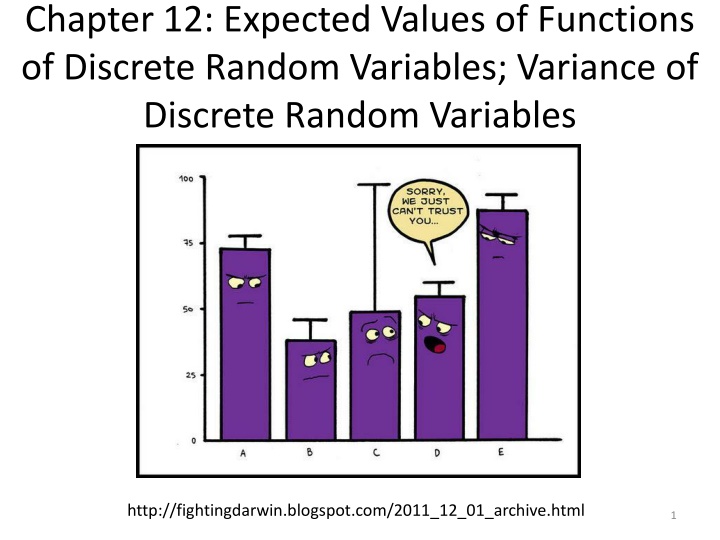
Expected Values and Variance in Discrete Random Variables
Explore the concepts of expected values and variance in discrete random variables through examples involving functions and scenarios like automobile insurance and bus students. Learn how to calculate expected values and variances, and understand their properties.
Download Presentation

Please find below an Image/Link to download the presentation.
The content on the website is provided AS IS for your information and personal use only. It may not be sold, licensed, or shared on other websites without obtaining consent from the author. If you encounter any issues during the download, it is possible that the publisher has removed the file from their server.
You are allowed to download the files provided on this website for personal or commercial use, subject to the condition that they are used lawfully. All files are the property of their respective owners.
The content on the website is provided AS IS for your information and personal use only. It may not be sold, licensed, or shared on other websites without obtaining consent from the author.
E N D
Presentation Transcript
Chapter 12: Expected Values of Functions of Discrete Random Variables; Variance of Discrete Random Variables http://3.bp.blogspot.com/-J33vbwkO6m4/TtwbsY6X6sI/AAAAAAAADOE/-ny0agMrm8c/s1600/High_Variance_High_SD.jpg http://fightingdarwin.blogspot.com/2011_12_01_archive.html 1
Example: Expected Value of a Function Consider a situation where a discrete random variable can have the values from -2 to 2. (Like a person can take a seat up to 2 places to the left of center (-2) and 2 places to the right of center (+2).) What is E(X2)? 2
Example: (2nd time) An individual who has automobile insurance form a certain company is randomly selected. Let X be the number of moving violations for which the individual was cited during the last 3 years. The PMF of X is x 0 pX(x) 0.60 1 2 3 0.25 0.10 0.05 a) If the cost of insurance depends on the following function of accidents, g(x) = 400 + (100x - 15), what is the expected value of the cost of the insurance? b) What is the expected value of X2? 3
Example: Variance A school class of 120 students are driven in 3 buses to a basketball game. There are 36 students in one of the buses, 40 students in another, and 44 on the third bus. When the buses arrive, one of the 120 students is randomly chosen. Let X denote the number of students on the bus of that randomly chosen student. Find the variance of X. 4
Example: Properties of Variance An individual who has automobile insurance form a certain company is randomly selected. Let X be the number of moving violations for which the individual was cited during the last 3 years. The PMF of X is X 0 1 2 3 pX(x) 0.60 0.25 0.10 0.05 a) If the cost of insurance depends on the following function of accidents, g(x) = 400 + (100x- 15), what is the variance of the cost of insurance? 5
Example: Properties of Variance (cont) An individual who has automobile insurance form a certain company is randomly selected. Let X be the number of moving violations for which the individual was cited during the last 3 years. The PMF of X is X 0 pX(x) 0.60 0.25 1 2 3 0.10 0.05 b) If the cost of insurance depends on the following function of accidents, g(x) = 400 + (100x- 15), what is the variance of the cost of insurance for 3 people who are independent? 6
